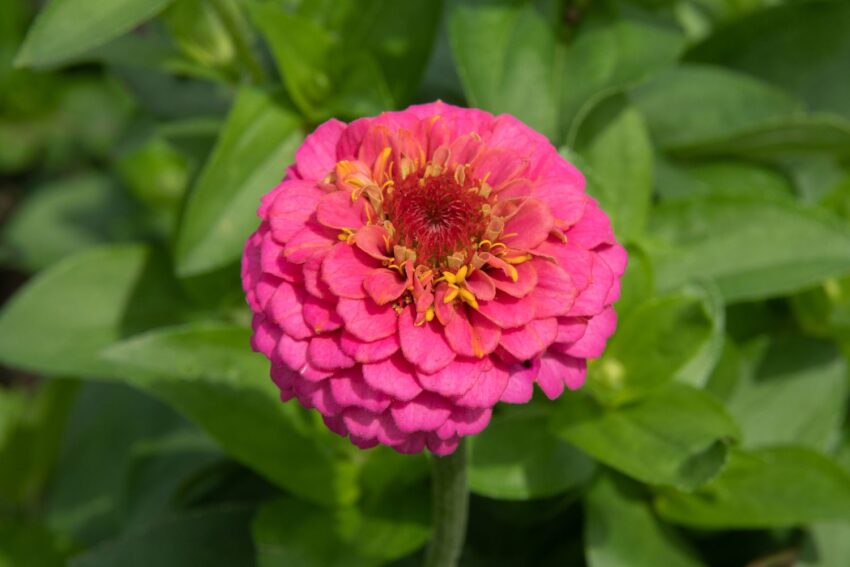Zinnia elegans, commonly known as zinnia, is a beautiful and colorful annual flower that is easy to grow in your garden or in containers. This article will provide you with all the information you need to care for and plant zinnias, from selecting the right location and soil to harvesting the seeds. The article is contributed by Begardenly.
Introduction to Zinnia Elegans

Zinnia elegans is a member of the Asteraceae family and is native to Mexico. It is an annual plant that can grow up to 3 feet tall and has a variety of colors, including red, pink, yellow, orange, white, and purple. Zinnias are popular among gardeners because they are easy to grow, require little maintenance, and attract pollinators such as bees and butterflies.
Selecting the Right Location
Zinnias require a location with full sun exposure, at least six hours a day. They can grow in most types of soil, but it should be well-draining and rich in organic matter. Zinnias do not tolerate wet soil or standing water, so make sure the area is well-draining. Keep reading: HOW TO DEADHEAD ANEMONES
Planting Zinnias
Planting From Seeds
Zinnias are best grown from seeds, which can be planted directly in the garden or in containers. Start planting the seeds after the last frost, which is usually in the spring. Follow these steps to plant zinnias from seeds:
- Prepare the soil: Loosen the soil and remove any weeds or debris.
- Sow the seeds: Scatter the seeds over the soil and cover them with a thin layer of soil, about 1/4 inch deep.
- Water the seeds: Water the seeds gently to keep the soil moist but not waterlogged.
- Thin the seedlings: Once the seedlings have grown to about 2 inches tall, thin them out to a distance of 6 to 18 inches apart, depending on the variety.
Planting From Transplants
You can also plant zinnias from transplants, which are seedlings that have already been started in a greenhouse. Transplants can be planted after the last frost, in the same way as seeds. Follow these steps to plant zinnias from transplants:
- Prepare the soil: Loosen the soil and remove any weeds or debris.
- Dig a hole: Dig a hole that is slightly larger than the root ball of the transplant.
- Place the transplant: Place the transplant in the hole and cover with soil.
- Water the transplant: Water the transplant gently to keep the soil moist.
Caring for Zinnias
Watering
Zinnias require regular watering, especially during hot and dry weather. Water them deeply once a week or more often if the soil is dry.
Fertilizing
Zinnias do not require much fertilizer, but you can give them a boost by adding a balanced fertilizer, such as a 10-10-10, once a month during the growing season.
Deadheading
Deadheading is the process of removing spent flowers to encourage new growth and more blooms. Simply pinch off the spent flowers at the base of the stem.
Pests and Diseases
Zinnias are generally not prone to pests and diseases, but they can be affected by aphids, spider mites, and powdery mildew. You can control aphids and spider mites by spraying the plants with a mixture of water and dish soap. Powdery mildew can be prevented by spacing the plants apart to allow for good air circulation.
Harvesting Zinnia Seeds
Zinnia seeds are easy to harvest and can be saved for future planting or shared with fellow gardeners. Follow these steps to harvest zinnia seeds:
- Allow the flowers to dry on the plant: Let the zinnia flowers dry on the plant until the petals fall off and the seed heads turn brown.
- Remove the seed heads: Cut off the seed heads using clean scissors or pruning shears.
- Remove the seeds: Break open the seed heads and remove the seeds. You can store the seeds in a dry, cool place until the next planting season.
In conclusion, zinnia elegans is a beautiful and low-maintenance flower that can brighten up any garden or container. By selecting the right location and soil, planting seeds or transplants, and caring for the plants through watering, fertilizing, and deadheading, you can enjoy a colorful display of zinnias throughout the growing season. Remember to also harvest the seeds for future planting and to share with fellow gardeners.




